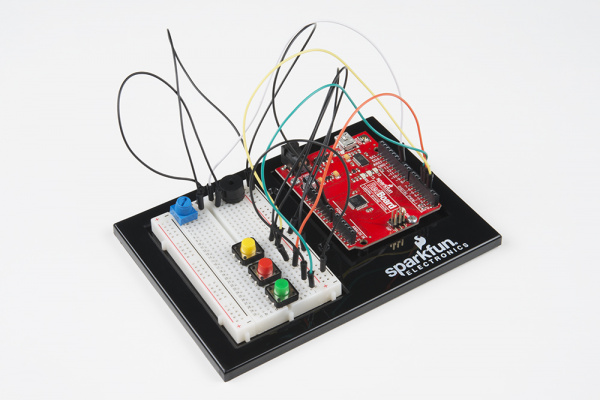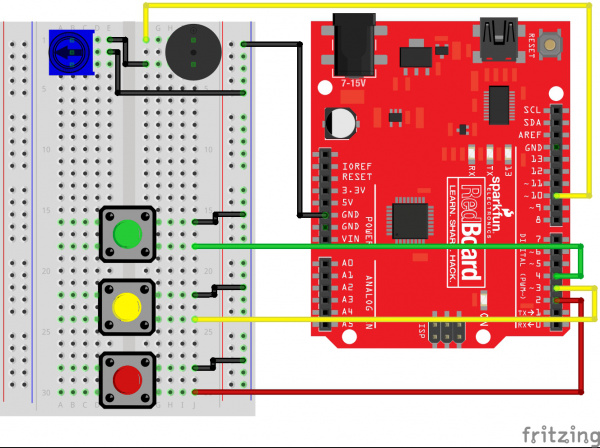Show of hands - anyone use Fritzing? I do, and I have a feeling I'm about to open a can of worms. The discussion must be had, however, so let's dive in, shall we? If you aren't familiar with Fritzing, swing on by Fritzing.org and have a poke-see around. There's plenty of functionality - you can layout, prototype, teach and manufacture custom PCBs as well.
Like most applications, Fritzing has definitive pros and cons. At SparkFun, we use Fritzing diagrams in our SIK kits, tutorials, hookup guides and workshops - it's a great tool to show quickly and cleanly how we have hooked something up. Let's look at an example from the SparkFun Inventor's Kit:
 |
 |
| Circuit 2B: Digital Trumpet | Fritzing Diagram from Circuit 2B: Digital Trumpet |
Easier, right? Basically, we use Fritzing as a "gateway drug" to get beginners and hobbyists involved in electronics. That said, it can be extremely non-intuitive to work with. For us, creation of new parts requires a fair amount of manual massage, and it's not easy to deliver our parts to the public at large.
While Fritzing is open source, not much has happened with application development in recent years. In the last couple months there has been discussion about reviving development on the Fritzing application, but I haven't been able to ascertain a clear direction for said development. If you have a bit, the video is worth a watch. Patrick Franken does a good job of acknowledging the benefits/scope of limitations, as well as discussing the current and future development (or lack thereof). On the upshot, it IS open source, so we can all contribute. If you want to have a look at or add to the development discussion, head on over to the Fritzing GitHub.
Since our use-case here at SparkFun is fairly specific, our view of Fritzing is naturally going to be somewhat myopic. We are always striving for better ways to get people involved and excited about electronics, and my goal in opening up this discussion is to find out what is most helpful to the community at large.
So now the real questions begin. How do you use Fritzing? Are there alternatives you find helpful when teaching others how to hook up their projects? What do you find most helpful about Fritzing, vs. what you would like to see changed in how we present hookup designs?
Constructive comments here are great (no flame wars please) and if you'd like to be further involved in the discussion, feel free to head on over to our newly revamped forums.






khá hay
I want more Fritzing... Ok most of my use has been to document projects - and Fritzing is great at this with both it's schematic and breadboard view. All of these tools have yucky learning curves, and I'd rather not learn a tool for PCB work (which I am in 'getting started' mode with) and a different tool for documentation. (FYI by documentation, I mean slides for my local electronics (ham) club.)
Also, Simon Monk has a great book on Fritzing! (Got me started) 73
What kind of monster uses a combination of a red thing, a yellow thing, and a green thing, THEN DOSN'T PUT THEM IN ORDER?!!? AAARRRGGGGGGGGG!!!!!!!!
OMG - this made me full on laugh - I saw that too! I should've chosen a different image but with the blizzard and shutdown happening I had bigger fish to fry. It's an image from our SIK kit projects, which I think may be getting a revision at some point soon. I will definitely point that out to them! Thank you for the feedback, I'm glad I'm not the only totally OCD person out there. :D
I like using Fritzing for basic diagrams in the breadboard view. It can be hard to follow when displaying a physical image of the part with several wires coming out of a development board to other components. Fritzing highlights the important parts of the board with a top view. The trade off is that making a part from scratch is tedious and time consuming without the proper software and scripts. It can also be hard to follow along if boards are stacked.
The schematic view is nice but I feel like the PCB view is overkill and I would prefer to just use Eagle (especially if the board was going to be printed).
I use Fritzing for some things, though tend to use KiCad for more complex things. (I try to avoid Buzzard, er, Eagle.)
I think it's a bit ironic that a post entitled Puttin' on the Fritz was posted the day the SparkFun servers had so many problems! ;-)
(Been trying to submit thia comment for over 24 hours. Thank goodness for computer clipboards!)
LOL - I thought about that! That "bomb cyclone" was no joke. I think the whole state shut down and there are still people without power. Today it is 45 and sunny. Colorado weather is weird!
Same. Ha ha. Clipboards save the day for me too. ;)
My main problem with Fritzing has always been the amount of pain to add new parts. I prefer the look of Fritzing to other applications when technical cartoons are best suited as the means of communication. In the end I found it took less time to build a bunch of shapes in things like Visio that looked close enough.
I can't say I've ever tried the PCB tool enough to have an opinion because the experience stopped when the Library didn't have a workable part ready to use.
This is my biggest pain point as well. Hence my post. If there is an alternative that the world at large likes better I'm all for it but so far I haven't found anything that is quite as clear. It may be that I dig into the Eagle2Fritzing fork and fix the build issues and customizations but I haven't quite committed myself to that yet. :D
I use Fritzing just for hobbyist things. I've had a couple boards printed from OSH Park with it and they turned out great.
I chose Fritzing because it was available on the Mac and pretty easy to use. I'd definitely like to see more development on it though. It can be wonky at times.
First, while no flames for Fritzing, about 10 gigatons of flames for your stupid captchas when logging in. It took me longer to play Mother-may-I with your system than to write this comment. Couple that with the fact that one has to be logged in to buy anything, it really has cut back the impulse buying from you guys. My reaction now when I see something interesting is to check Adafruit to see if they have it. If you must use them but don't want to chase us away permanently, use images that can actually be seen, instead of all those small blurry incomprehensible ones. End of flame.
As far as Fritzing goes, I've never felt a need to use it. I'm not trying to share stuff with newbies, which is where Fritzing excels. It reminds me of the old Heathkit pictorials, the illustrations in the old Radio Shack manuals and the beautiful illustrations in the Alfred Morgan Boy's Book of Radio and Electronics series (great stuff in there for girls, too, BTW), just updated for screen display. Personally, I feel as if I've outgrown pictorials and prefer schematics, unless the pictorial is communicating some strange or potentially confusing mechanical data. But that's a personal preference, nothing against Fritzing.
My main gripe against it is the name.
Agreed on the captchas. I'm not sure we actually control that - I think it is third party - but it is definitely painful. I'll bring it up with our IT team though and see what they say.
Thank you for the feedback!